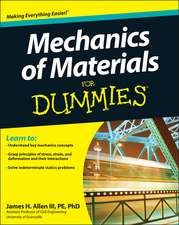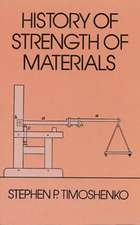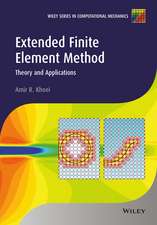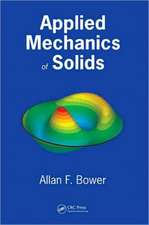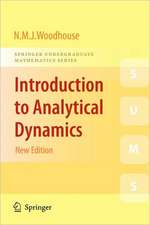Finite Element Methods for Nonlinear Problems: Proceedings of the Europe-US Symposium The Norwegian Institute of Technology, Trondheim Norway, August 12–16, 1985
Editat de Pal G. Bergan, K.J. Bathe, W. Wunderlichen Limba Engleză Paperback – 10 ian 2012
Preț: 666.73 lei
Preț vechi: 784.39 lei
-15% Nou
Puncte Express: 1000
Preț estimativ în valută:
127.58€ • 131.62$ • 106.47£
127.58€ • 131.62$ • 106.47£
Carte tipărită la comandă
Livrare economică 27 martie-10 aprilie
Preluare comenzi: 021 569.72.76
Specificații
ISBN-13: 9783642827068
ISBN-10: 3642827063
Pagini: 836
Ilustrații: X, 820 p. 43 illus.
Dimensiuni: 155 x 235 x 44 mm
Greutate: 1.15 kg
Ediția:Softcover reprint of the original 1st ed. 1986
Editura: Springer Berlin, Heidelberg
Colecția Springer
Locul publicării:Berlin, Heidelberg, Germany
ISBN-10: 3642827063
Pagini: 836
Ilustrații: X, 820 p. 43 illus.
Dimensiuni: 155 x 235 x 44 mm
Greutate: 1.15 kg
Ediția:Softcover reprint of the original 1st ed. 1986
Editura: Springer Berlin, Heidelberg
Colecția Springer
Locul publicării:Berlin, Heidelberg, Germany
Public țintă
ResearchDescriere
This book contains a collection of papers presented at the Europe-US Symposium on Finite Element Methods for Nonlinear Problems. The symposium was held at the Norwegian Institute of Technology, Trondheim, Norway during August 12 to 16, 1985. The finite element method has during recent years gained a position as the most important discipline in computational mechanics. The basis for this method was laid out about two decades ago, and linear finite element techniques are today well established and well understood. Much work is still being done in order to make these linear methods more efficient and reliable. However, a sub stantial part of the current research efforts in the finite element field is focused on developing the nonlinear capabilities of the method. This task is highly challenging and demanding, both from a theoretical and practical point of view. It was in this spirit that the Europe-US Symposium on Finite Element Methods for Nonlinear Problems was organized. The meeting may be seen as the continuation of the US-Germany Symposium on Finite Element Methods held in 1976 at MIT, Cambridge, USA and the Europe- US Workshop on Nonlinear Finite Element Analysis in Structural Mechanics held in 1980 at the Ruhr-Universitat, Bochum, West-Germany.
Cuprins
I: Fundamental Problems.- On the accuracy and efficiency of numerical algorithms for geometrically nonlinear structural analysis.- Large rotations in problems of structural mechanics.- Kinematic and dynamic analysis of mechanisms a finite element approach based on Euler parameters.- A discussion of Cauchy stress formulations for large strain analysis.- II: Nonlinear Materials.- Distributed cracking and nonlocal continuum.- On the numerical simulation of tensile fracture.- Stability and uniqueness of strain-softening computations.- An endochronic approach and other topics in small and finite deformation computational elasto-plasticity.- Elastoplastic material laws with linear yield conditions.- On large strain elasto-plastic and creep analysis.- Dynamic soil-structure interaction with constitutive modelling for soils and interfaces.- III: Frames, Plates and Shells.- Analysis procedure for space frames with material and geometrical nonlinearities.- Nonlinear finite element analysis of offshore structures.- Constraints for stresses in hybrid plate and shell elements.- A family of C0 shell elements based on generalized Hrennikoff’s Method and assumed natural-coordinate strains.- Elastic-plastic and geometrically nonlinear analysis of plates and shells using a new nine node element.- Improved spurious mode control through mixed variational principles.- Nonlinear shell analysis using free formulation finite elements.- Ultimate load analysis of thin shells under pressure loads.- Computational procedures for postbuckling of composite shells.- IV: Solution techniques and computer methods.- Reduction method for the nonlinear analysis of symmetric anisotropic panels.- Global constraints in nonlinear solution strategies.- On some efficient solution algorithms for nonlinear finite element analysis.- Nice: a utility architecture for computational mechanics.- Implementation of a modified Hughes-Liu shell into a fully vectorized explicit finite element code.- Adaptive substructuring techniques for finite element analysis with localized nonlinearities.- V: Dynamics.- Improvements in transient dynamic time integration with application to spent nuclear fuel shipping cask impact analyses.- Nonlinear dynamic analysis of shell structures using general single step algorithms.- Dynamic quasi-bifurcations in structures subjected to step loadings.- Finite strip analysis of blast loaded plates.- Simplified dynamic analysis of civil engineering structures.- VI: Reinforced concrete.- Some aspects of modelling reinforced concrete structures by finite elements.- Development and application of a gradient-dependent fracture criterion for finite-element analysis of reinforced-concrete surface structures.- A finite element technique for analysis of reinforced and prestressed concrete structures.- Nonlinear analysis of concrete and masonry structures.- Finite element analysis of the nonlinear response of concrete dams subjected to internal loads.- VII: Contact Problems.- On the influence of contact boundary conditions on the stability of shell structures under follower loads.- Nonlinear analysis of shells of revolution including contact conditions.- Finite element postbuckling analysis of shells with nonlinear contact constraints.- Augmented Lagrangian techniques for solving frictionless contact problems in finite elasticity.- VIII: Fluids.- Entropy-stable finite element methods for compressible fluids: application to high Mach number flows with shocks.- Analysis on a Taylor weak-statement algorithm for CFD applications.- An optimal 3D finite element for incompressible media.- A spectral element method for solution of the two- and three-dimensional time-dependent incompressible Navier-Stokes equations.

